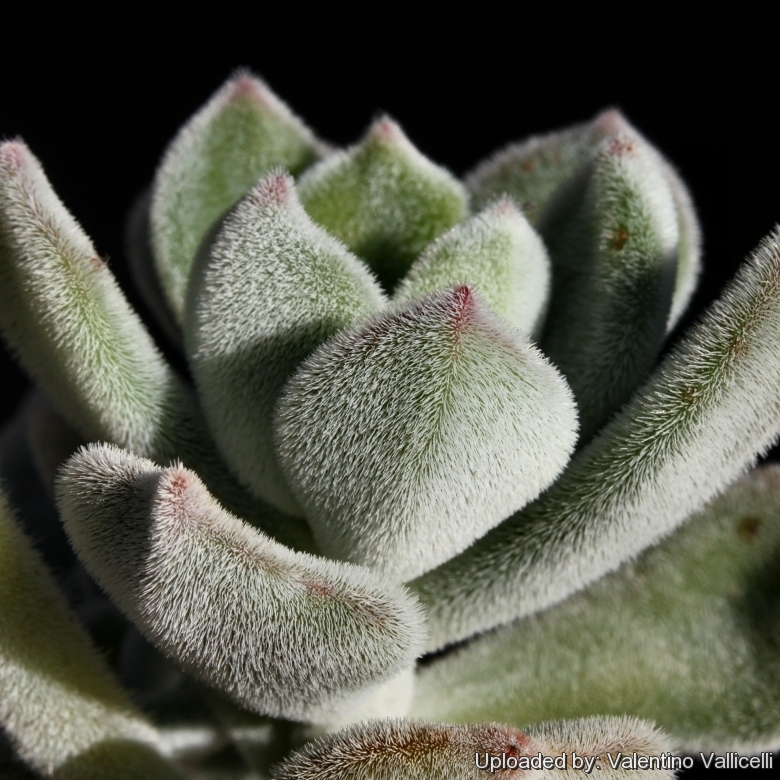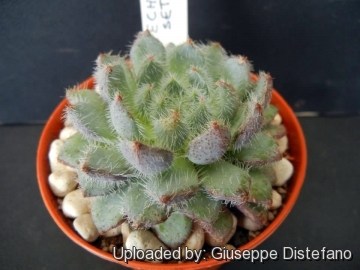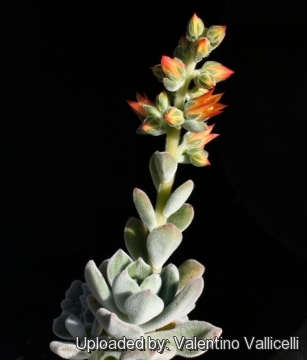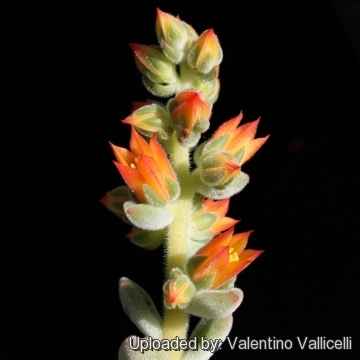
Echeveria setosa Photo by: Valentino Vallicelli
The leaves are densely covered by white hairs. Leaves are tipped reddish in cold temperatures.
Origin and Habitat: Mexico. (Puebla, Oxaca)
Synonyms:
See all synonyms of Echeveria setosa
Common Names include:
ENGLISH: Mexican Fire Cracker, Firecracker Plant, Hens and Chicks
RUSSIAN (Русский): Эxеверия щетинистая
Description: Echeveria setosaSN|12352]]SN|12352]] is an almost stemless, slowly clustering, rosette-succulent that forms in dense mounds. It is a very distinct echeveria, with a remarkable pubescence, but extremely variable. Plants varies from almost glabrous to very furry with stiff, glistening white hairs, depending on the variety. It clusters freely giving off offsets from the base and readily forming dense mounds.
Rosettes: Globose 5 to 15 cm depending on clones.
Leaves: Up to 100 per rosette, convex on both sides, narrow, densely packed spatulate-shaped, glabrous or hairy, depending on the variety, glaucous or green, that in the winter assumes a green-red colouring.
Inflorescence: Simple or 2 branched erect, arched helicoid second cincinni from each rosette.
Flowers: The flowers are the most distinctive and recognisable feature of this species, they are displayed in erect, arched helicoid cymes from each rosette that reach from about 15 cm to 20 cm tall, each with about 6 to 9 florets. In larger groups of rosettes, often of the inflorescences are branched. The flowers are red and yellow simple or 2 branched second cincinni. The corolla campanulate or ovoid urceolate, prominently pentagonal.
Blooming season (Europe): Late April to early July.
Subspecies, varieties, forms and cultivars of plants belonging to the Echeveria setosa group
 Echeveria setosa Rose & J.A.Purpus: Almost glabrous to very furry with stiff, glistening white hairs, depending on the variety. it is a rosette succulent freely giving off offsets from the base and readily forming dense mounds.
Echeveria setosa Rose & J.A.Purpus: Almost glabrous to very furry with stiff, glistening white hairs, depending on the variety. it is a rosette succulent freely giving off offsets from the base and readily forming dense mounds.- Echeveria setosa var. ciliata (R.Moran) R.Moran: It is a broader leaved plant, with somewhat fewer bristles at the edges of the green leaves.
 Echeveria setosa f. cristata hort.: Attractive crested form with very fuzzy, silvery leaves that feel to the touch like
Echeveria setosa f. cristata hort.: Attractive crested form with very fuzzy, silvery leaves that feel to the touch like
a cross between felt and velvet. Echeveria setosa var. deminuta J.Meyran: This plant has been in cultivation for some time as “E. rundelii”” It has tiny, blue, clubshaped leaves with a tuft of bristles at the ends, the rosettes are no bigger than about 3 cm. It form dense many headed clusters.
Echeveria setosa var. deminuta J.Meyran: This plant has been in cultivation for some time as “E. rundelii”” It has tiny, blue, clubshaped leaves with a tuft of bristles at the ends, the rosettes are no bigger than about 3 cm. It form dense many headed clusters.- Echeveria setosa var. minor R.Moran: It is a plant that combine the best of var. deminuta and var. ciliata, the leaves are covered with fine bristles, it form a a pale blue flattish rosette about 8 cm wide.
- Echeveria setosa var. oteroi R.Moran
Bibliography: Major references and further lectures.
1) Werner Rauh “The Wonderful World of Succulents: Cultivation and Description of Selected Succulent Plants Other Than Cacti” Smithsonian Institution Press, 1984
2) James Cullen, Sabina G. Knees, H. Suzanne Cubey "The European Garden Flora Flowering Plants: A Manual for the Identification of Plants Cultivated in Europe, Both Out-of-Doors and Under Glass" Cambridge University Press, 11/ago/2011
3) Hermann Jacobsen ”A Handbook of Succulent Plants: Abromeitiella to Euphorbia” Blandford Press, 1960
 Echeveria setosa Photo by: Giuseppe Distefano
Echeveria setosa Photo by: Giuseppe Distefano Echeveria setosa Photo by: Valentino Vallicelli
Echeveria setosa Photo by: Valentino Vallicelli Echeveria setosa Photo by: Valentino Vallicelli
Echeveria setosa Photo by: Valentino VallicelliSend a photo of this plant.The gallery now contains thousands of pictures, however it is possible to do even more. We are, of course, seeking photos of species not yet shown in the gallery but not only that, we are also looking for better pictures than those already present.
Read More... Cultivation and Propagation: It is essential in cultivation to use a very porous soil, with adequate drainage.
Exposition: Bright light is required to prevent "stretching" of Echeverias ("stretching" occurs when a moderately fast growing plant such as an Echeveria, is grown in dim light or over-fertilized, which causes overly lush growth that contributes to weak, pallid plants).
Watering: Water thoroughly when soil is dry to the touch.
Hardiness: Protect from frost.
Propagation: Quite easy from seed or from cuttings, the latter either from individual leaves or from offset rosettes.













